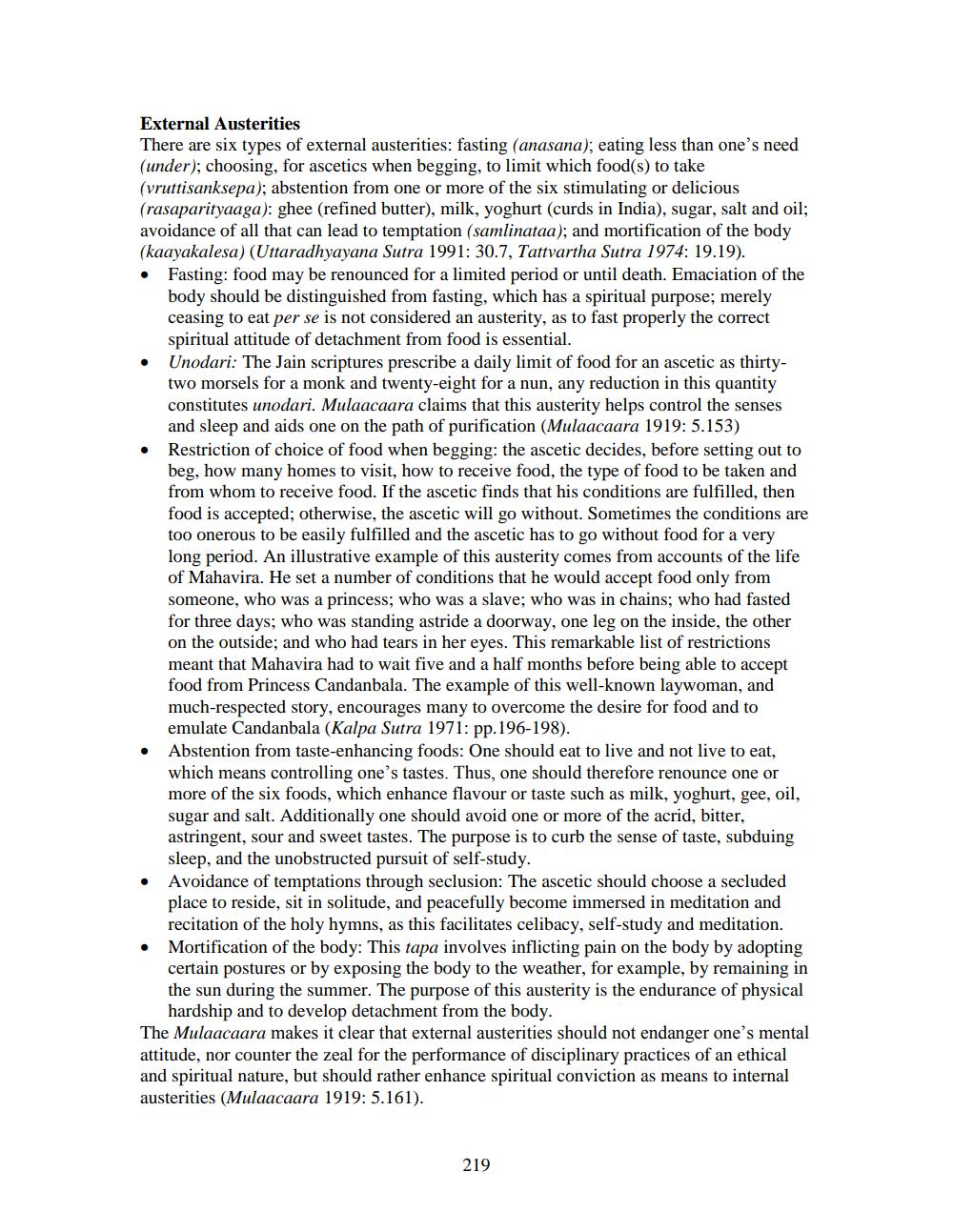________________
External Austerities There are six types of external austerities: fasting (anasana); eating less than one's need (under); choosing, for ascetics when begging, to limit which food(s) to take (vruttisanksepa); abstention from one or more of the six stimulating or delicious (rasaparityaaga): ghee (refined butter), milk, yoghurt (curds in India), sugar, salt and oil; avoidance of all that can lead to temptation (samlinataa); and mortification of the body (kaayakalesa) (Uttaradhyayana Sutra 1991: 30.7, Tattvartha Sutra 1974: 19.19).
Fasting: food may be renounced for a limited period or until death. Emaciation of the body should be distinguished from fasting, which has a spiritual purpose; merely ceasing to eat per se is not considered an austerity, as to fast properly the correct spiritual attitude of detachment from food is essential. Unodari: The Jain scriptures prescribe a daily limit of food for an ascetic as thirtytwo morsels for a monk and twenty-eight for a nun, any reduction in this quantity constitutes unodari. Mulaacaara claims that this austerity helps control the senses and sleep and aids one on the path of purification (Mulaacaara 1919: 5.153) Restriction of choice of food when begging: the ascetic decides, before setting out to beg, how many homes to visit, how to receive food, the type of food to be taken and from whom to receive food. If the ascetic finds that his conditions are fulfilled, then food is accepted; otherwise, the ascetic will go without. Sometimes the conditions are too onerous to be easily fulfilled and the ascetic has to go without food for a very long period. An illustrative example of this austerity comes from accounts of the life of Mahavira. He set a number of conditions that he would accept food only from someone, who was a princess, who was a slave; who was in chains; who had fasted for three days; who was standing astride a doorway, one leg on the inside, the other on the outside; and who had tears in her eyes. This remarkable list of restrictions meant that Mahavira had to wait five and a half months before being able to accept food from Princess Candanbala. The example of this well-known laywoman, and much-respected story, encourages many to overcome the desire for food and to emulate Candanbala (Kalpa Sutra 1971: pp. 196-198). Abstention from taste-enhancing foods: One should eat to live and not live to eat, which means controlling one's tastes. Thus, one should therefore renounce one or more of the six foods, which enhance flavour or taste such as milk, yoghurt, gee, oil, sugar and salt. Additionally one should avoid one or more of the acrid, bitter, astringent, sour and sweet tastes. The purpose is to curb the sense of taste, subduing sleep, and the unobstructed pursuit of self-study. Avoidance of temptations through seclusion: The ascetic should choose a secluded place to reside, sit in solitude, and peacefully become immersed in meditation and recitation of the holy hymns, as this facilitates celibacy, self-study and meditation. Mortification of the body: This tapa involves inflicting pain on the body by adopting certain postures or by exposing the body to the weather, for example, by remaining in the sun during the summer. The purpose of this austerity is the endurance of physical
hardship and to develop detachment from the body. The Mulaacaara makes it clear that external austerities should not endanger one's mental attitude, nor counter the zeal for the performance of disciplinary practices of an ethical and spiritual nature, but should rather enhance spiritual conviction as means to internal austerities (Mulaacaara 1919: 5.161).
219




